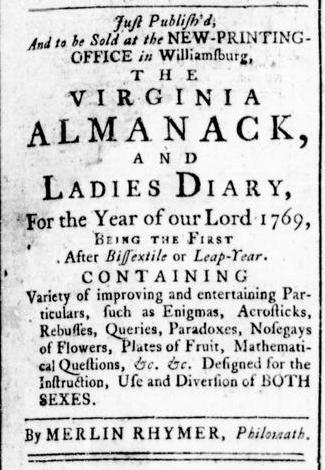What was advertised in a colonial American newspaper 250 years ago today?

William Rind got a jump on the market for almanacs for 1769, publishing The Virginia Almanack, and Ladies Diary, for the Year of Our Lord 1769 in June of 1768. He began advertising the almanac more than six months before the new year commenced, deviating significantly from the practices of most printers who published almanacs. Usually advertisements for almanacs began appearing in September and October, often announcing plans for publishing specific titles and promising that they would go to press soon. Such advertisements attempted to incite demand for products that were not yet available for purchase, seeking to predispose customers to specific titles long before they needed to acquire an almanac for the coming year. Advertisements announcing that almanacs had indeed been published and calling on customers to obtain their copies usually began appearing in November and December, increasing in number and frequency as January approached. Some of those advertisements continued after the first of the year as printers sought to relieve themselves of surplus copies, but they steadily tapered off. Most disappeared by the middle of February, though some advertisements continued to pop up at irregular intervals. The day before Rind promoted the Virginia Almanack in the Virginia Gazette, Charles Crouch inserted a brief advertisement in his South-Carolina Gazette and Country Journal that simply announced, “BALL’s ALMANACKS for the Year 1768, to be sold by the Printer.” Attempts to sell leftover almanacs for the current year continued even as the earliest of advertisements marketed almanacs for the coming year.
Rind realized that the end of June 1768 was indeed early for distributing an almanac for 1769. Accordingly, his advertisement did not include the usual information about the accuracy of the astronomical calculations or other aspects of the calendar specific to certain days or months. Instead, he focused on the “Variety of improving and entertaining Particulars” contained within the almanac, contents that could be consulted and enjoyed no matter the season or year. These included “Enigmas, Acrosticks, Rebusses, Queries, Paradoxes, … [and] Mathematical Questions” that were “Designed for the Instruction, Use and Diversion of BOTH SEXES.” Rind also listed “Nosegays of Flowers” and “Plates of Fruit.” Although these could have refered to illustrations, the American Antiquarian Society’s entry for the Virginia Almanack indicates that “[t]he Anatomy … is the only illustration.” Rind likely meant “Nosegays of Flowers” and “Plates of Fruit” figuratively, evoking the pleasures to be derived from perusing the many and varied contents of the almanac. Considering the schedule followed by most other printers, it was indeed early for publishing and advertising an almanac, but Rind adjusted his marketing to compensate and perhaps even generate greater demand than if he had waited until the fall.
